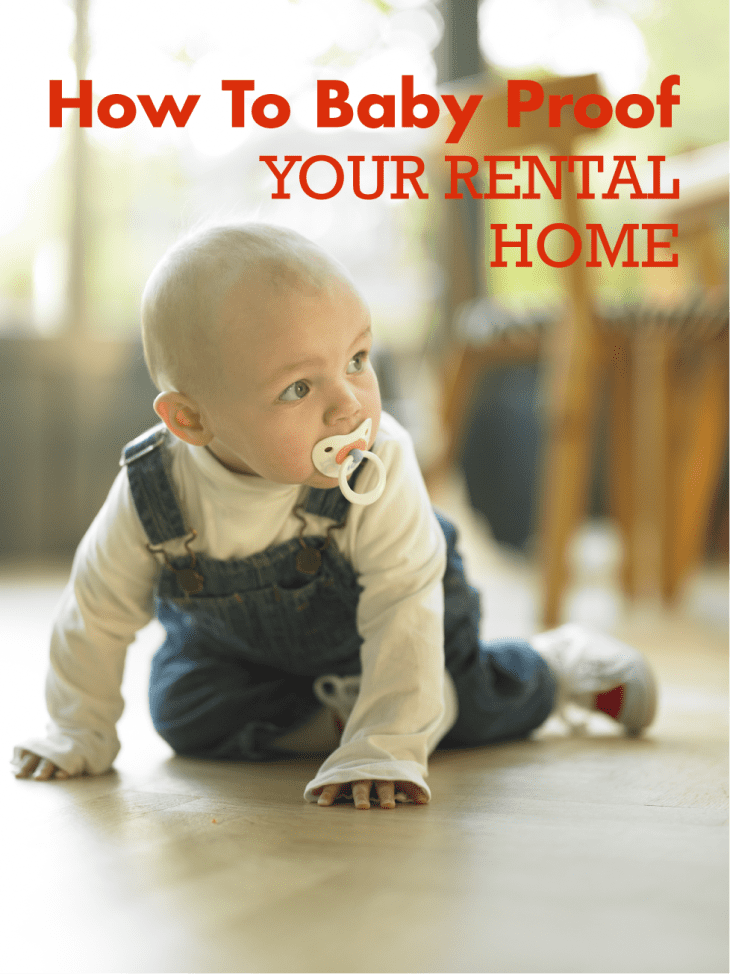How To Baby Proof Your Rental

Uh-oh. Has that baby of mine really worked out how to get in the refrigerator? Already? And the cabinets? Time to baby proof our rental. But how, when there is so little we can change? Here are a few of the challenges we renters face when baby-proofing, and the simple steps we can take to overcome them.
Challenge #1: Finding the safest possible property for your family to rent
If you can, start at the very beginning. When looking at a property, speak to the landlord about any safety concerns you have about the space. Does the landlord seem flexible with regard to screwing items into walls (like anchoring a bookshelf, for example)? This will help you gauge whether or not you can form a working relationship with this person.
In terms of the property itself, check for these potential problems:
- Are there dangerous falling hazards (like an open staircase) that cannot be blocked off by a gate?
- Do the window coverings have long cords or loops attached? These can be a strangulation hazard and will need to be replaced, cut, or secured to the wall – best to check with the landlord in advance rather than this turning into a problem later.
- Check for any odors in the property. Do the neighbors smoke, or has there been a smoker in the property before now? Cigarette smoke has been linked to SIDS and should be avoided.
- Lead paint is also a concern in any property built before 1978. For older homes, check: Is there any chipping or flaking of paint, especially around staircases and window and door frames? For more info, here is the EPA’s page on lead in homes.
Challenge #2: Blocking off potentially dangerous parts of your home
Then you need a baby gate. For a rental, this means searching for a “pressure-mounted” gate. This means discs on the gate screw out to hold the gate against the wall. However, if you have a set of stairs in your rental, and you need a gate at the top of the stairs, you must get a hard-mounted (actually screws into the wall) baby gate, because it is still possible that a pressure-mounted gate could be pushed through. Speak to your landlord. If this is an issue, offer to fill and repaint holes left by the gate, or consider paying to have this done. (A baby gate at the bottom of a set of stairs, however, is fine to be pressure-mounted.)
Challenge #3: Preventing access to cabinets where needed
Many cabinet door locking systems require screwing into the cabinetry, but not all. You can try these KidCo magnetic locks, which can be applied with adhesive, or these adhesive straps from Munchkin (these work for my refrigerator – no more climbing!). If you are lucky enough to have handles on your cabinet doors, try a handle lock like this one from Kiscords. Of course, the cheapest option is to simply rethink the layout of your storage. Keep the lower cabinets in your house for pots, pans and plastic items, while breakables and any dangerous goods like medicines and cleaning products should be kept far, far out of reach.
Challenge #4: Preventing toddlers from escaping through the front door
This is a huge problem in the apartment building I live in. We have bizarre door handles that no baby proof cover seems to fit, and they do not stay locked if turned from the inside. Which means that, as soon as my 3-year-old was strong enough to open the door, he escaped into the hallway. After speaking to my landlord, I discovered the installation of an extra chain or lock was not an option, as our doors need to be able to be opened from the outside at all times for fire safety reasons. To resolve this, they suggested installing a simple alarm system, to alert me to the door being opened. Something like this one. Hopefully your doors don’t have bizarro handles and you can simply purchase a regular baby proof door knob cover at your place.
→ Babyproofing Your Front Door
Challenge #5: Preventing falls from windows
This is such a crucial, but often overlooked, aspect of baby proofing. First of all, be sure that your child’s crib or bed is not next to a window, and consider moving any furniture that could be climbed on, away from the window in their room. In our house, no window is opened at the bottom wider than my toddler’s head (which is easy, since his head is in the 98th percentile). For homes with a normal-headed toddler, you may want to get yourself a window guard. Again, speak to your landlord as it will need to be drilled into the window frame. It’s worth it and could save your child’s life. Guardian Angel make great guards, and there is also this cheaper option from KidCo.
Of course, these are only a few points to consider when baby proofing your entire home. For a more comprehensive guide, take a look at these checklists on Babycenter, for what to do before your baby is born, before your baby starts to crawl, and for toddlers and beyond.
And if you’ve found the perfect solution to one of these rental baby-proofing dilemmas, be sure to share it with the rest of us below!
– Re-edited from a post originally published March 26, 2013 – DF